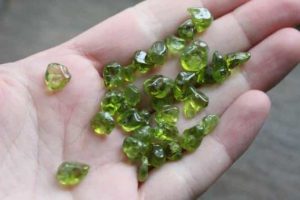
What is Peridot?
Peridot is a gem-quality olivine and a (Mg, Fe)2SiO4 type silicate mineral. The formulation approaches Mg2SiO4 because it is a magnesium-rich olivine (forsterite). The green colors of the gem depend on the structure of the iron contents. It occurs both in volcanic basalt and in pallastic meteorites in silica-deficient rocks. It is one of the two gems that have been observed to form in the rock of the upper mantle rather than in the earth’s crust. It’s gem-quality is unusual on the earth’s surface due to its environmental sensitivity when transporting deep into the mantle.
Peridot is a silicate of magnesium oxide; pure forsterite is colorless, but oxide substitute the green colors of some of the magnesium. Too much iron contributes to an attractive brown colored stone. It is the precious color without heavy yellow or brown distinctions, when it’s bright white. This altered barrel cut peridot is the most fine 46,16-carat stone in the National Gem Collection and Pakistan’s greatest peridot.
It is one of the few gemstones in one color only: an olive-green. But the size and color of the Green ranges from yellow to olive to brownish-gray in the crystal structure, depending upon the iron level of the structure. It may be medium-dark, pure white, in extreme situations, without a secondary yellow or brown mask.
Where is Peridot found?
The Olivine, a peridot type, is common to mafic and ultramatic rocks, frequently found in lava and in peridotite mantle xenoliths which carry Lava to the surface but only in a fraction of these environments does gem quality peridot occur.
Peridots in meteorites can also be detected.
It can be differentiated by composition and scale. A volcanically formed peridote typically has higher lithium, nickel and zinc concentrations than those present in meteorites.
Olivine is an abundant mineral, but peridot of gem quality is very unusual on the Earth’s surface due to its chemical instability. Olivine is typically classified as small grains and is not painted in a extremely heavy state. The variety that is used mostly to cut peridot diamonds, large forsterite crystals, is uncommon, which means olivines are considered valuable.
In the ancient world, mining of peridot, called topazios then, on St. John’s Island ” Zabargad Island “in the Red Sea began about 300 B.C.
The principal source of peridot olivine today is the San Carlos Apache Indian Reservation in Arizona. It is also mined at another location in Arizona, and in Arkansas, Hawaii, Nevada, and New Mexico at Kilbourne Hole, in the US; and in Australia, Brazil, China, Egypt, Kenya, Mexico, Myanmar (Burma), Norway, Pakistan, Saudi Arabia, South Africa, Sri Lanka, and Tanzania.
It’s crystals have been collected from some pallasite meteorites. These gems are given the name Moldavite to differentiate their origin. The most commonly studied pallasitic peridot belongs to the Indonesian Jeppara meteorite, but others exist such as the Brenham, Esquel, Fukang, and Imilac meteorites.
How much is a 1 carat peridot worth?
Peridot is around $50–80/ct in size. For the fine gems in the range of 1-2 ct, for the range of big fine gems up to $400-450 ct.
Is Peridot a natural stone?
A lot of Peridot gems come from ignorant environments. These gems form within the earth’s mantle to bring volcanic activity to the surface.
Are peridot stones valuable?
The price of peridot per carat is very varied. You will find beautiful peridot rings with silver setting for as little as $25, for example, and there are Peridot stones that can go a carat for around $900! The peridot value is determined by factors like colour, size, and quality.










